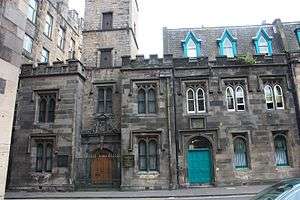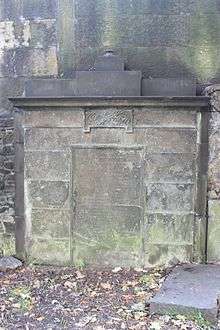Peter David Handyside
Dr Peter David Handyside FRSE FRCSE (1808–1881) was a Scottish surgeon and anatomist. He served as President of the Royal Medical Society in 1828. He won the Harveian Society Medal in 1827 and served as their Secretary in 1837. He was also President of the Medico-Chirurgical Society of Edinburgh in 1871.
Life


Handyside was born at 16 South Frederick Street[1] in Edinburgh’s New Town on 26 October 1808, the son of Jane Cuninghame and William Handyside WS (1746–1818), a lawyer. His elder brother Robert Handyside (1798–1858) came to the top of the Scottish legal world, becoming Lord Handyside. He was apprenticed to the eminent surgeon James Syme to train as a doctor. He studied medicine at the University of Edinburgh. He then undertook postgraduate studies first in Paris and then in Heidelberg under the eminent physiologist Friedrich Tiedemann.
He gained his doctorate (MD) from the University of Edinburgh in 1833.[2]
In 1833 he began lecturing in Anatomy at the University of Edinburgh later also lecturing in Systematic Surgery, both based at Surgeons Square. In 1836 he was elected a Fellow of the Royal Society of Edinburgh, his proposer being his mentor, James Syme. He served as a Councillor to the Society 1869–71.[3] In 1839 he became a Senior Surgeon at Edinburgh Royal Infirmary on Drummond Street. In 1858 he founded the Cowgate Medical Mission Dispensary in Edinburgh’s Old Town, aimed at giving relief to the poor (especially Irish Catholic) population in that area of the city. Under the subsequent leadership of William Thomson, this dispensary was later supplemented by the "Edinburgh Medical Missionary Society’s Training Institution" in 1861.[4] This was all housed in a building designed by Richard Crichton some 50 years earlier, attaching the Magdalene Chapel.[5] It was expanded and extended in 1878 to create the Livingstone Memorial Institute. This facility later evolved into EMMS International.
Handyside died at home, 16 Landsdowne Crescent in Edinburgh’s West End on 21 February 1881. He is buried with his parents in St Cuthberts Churchyard at the west end of Princes Street.[6] The grave lies to the south-east of the church very close to the entrance to Princes Street Gardens (screened by the Hamilton vault when approaching from the west).
Family
He was married to Eliza Walsh (1811–1882) and together they had three daughters.
References
- Edinburgh and Leith Post Office Directory 1808–09
- https://archive.org/stream/b21465812/b21465812_djvu.txt
- Biographical Index of Former Fellows of the Royal Society of Edinburgh 1783–2002 (PDF). The Royal Society of Edinburgh. July 2006. ISBN 0 902 198 84 X.
- Lowe, J. (1895). Medical missions: Their place and power. Fleming H. Revell Company. pp. 210.
- Edinburgh Ordnance Survey map 1895
- "William Handyside (1764-1816)". Find A Grave Memorial. Retrieved 10 April 2018.